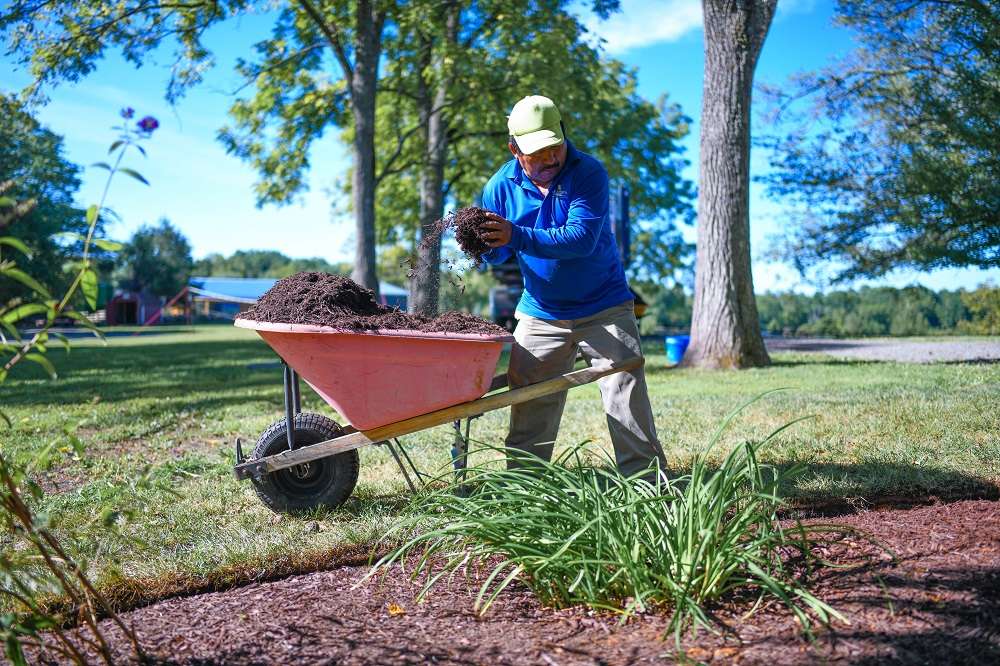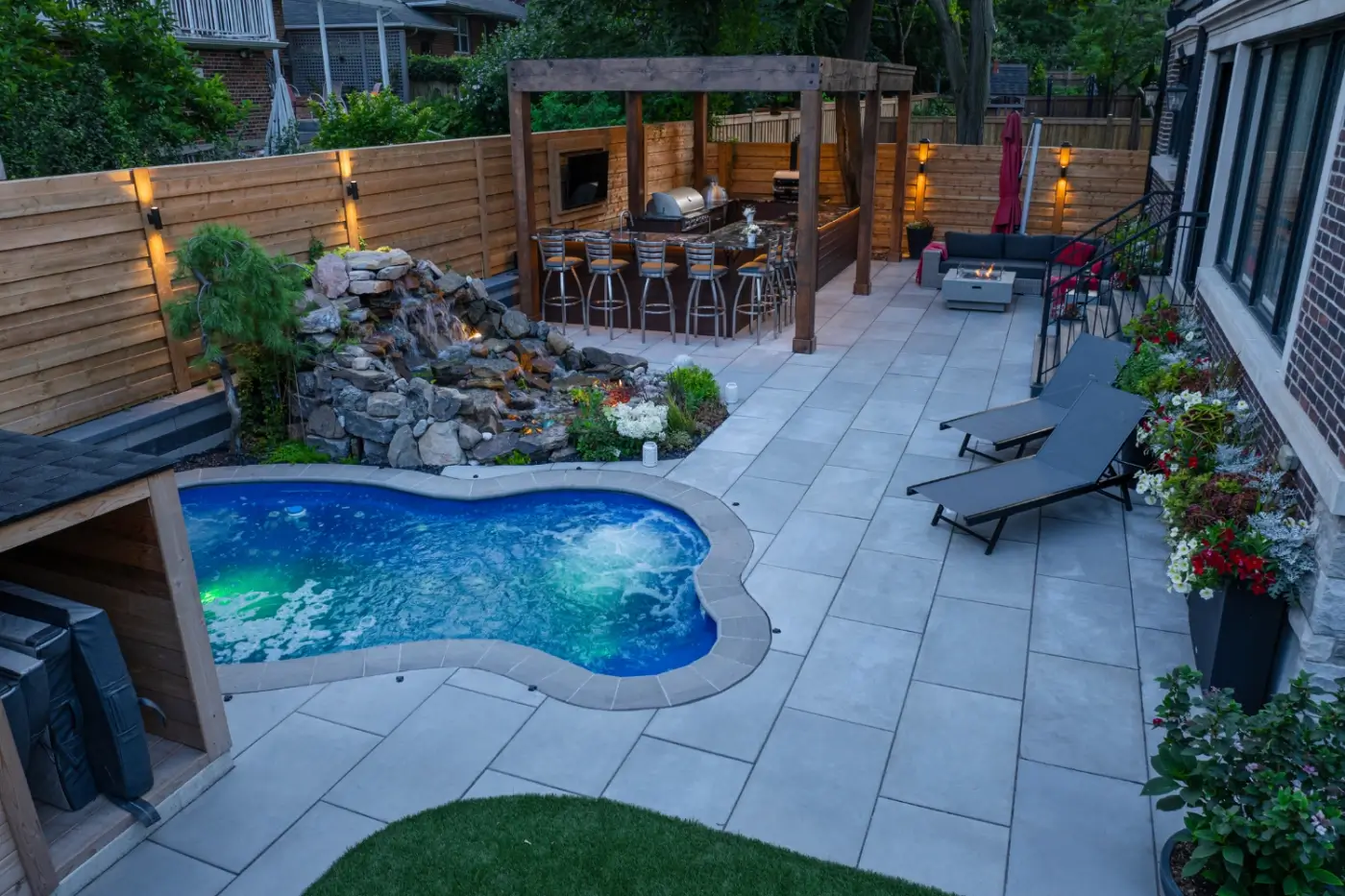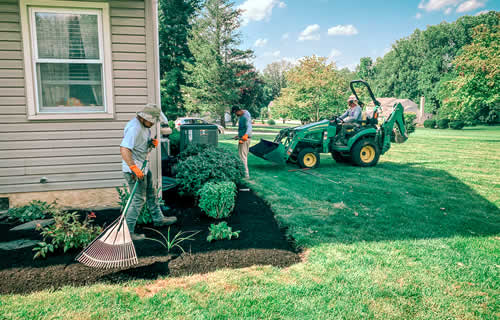Why landscaping services are essential for a beautiful and functional yard
Wiki Article
Comprehending the Comprehensive Extent of Works in Professional Landscape Design Services
The considerable extent of expert landscaping services encompasses a selection of basic aspects - landscaping. It includes landscape design concepts, plant choice, and hardscaping functions. Additionally, it addresses watering systems and upkeep techniques. Each aspect plays an important role in creating useful and cosmetically pleasing outside areas. Understanding just how these elements interact can disclose much about the art and science of landscape design. Nevertheless, the trip into this detailed field is just beginningLandscape Design Concepts
Effective landscape layout principles are essential for producing unified outside rooms that improve both visual charm and capability (Learn More). These concepts guide the arrangement of aspects within the landscape, making certain a cohesive visual experience. Secret parts include balance, which distributes visual weight uniformly; percentage, which connects the dimension of numerous elements to every various other and the room; and unity, which creates a feeling of integrity via consistent styles and products
Plant Option and Setup
In the domain of specialist landscaping, plant option and installment play an essential function in achieving a thriving yard. Emphasizing indigenous plant advantages, seasonal factors to consider, and the certain soil and sunshine requirements of each varieties guarantees a lasting and visually pleasing landscape. Careful preparation in these areas not only boosts biodiversity but likewise promotes long-term eco-friendly health and wellness.Indigenous Plant Advantages
Why should homeowners take into consideration native plants for their landscape design projects? Native plants supply various advantages that enhance both visual appeals and ecological sustainability. They are well-adapted to local environments, calling for less water and upkeep contrasted to non-native types. This resilience minimizes the need for chemical plant foods and chemicals, promoting a healthier ecosystem. In addition, native plants give habitat and food for neighborhood wildlife, consisting of pollinators, which can increase biodiversity in suburbs. Their knowledge with local soil and climate problems likewise brings about better development prices and longevity. By picking native plants, homeowners not just produce visually enticing landscapes but likewise add to environmental preservation, making a favorable impact on their local environment. Indigenous plants stand for a wise option for landscape design jobs.Seasonal Plant Considerations
House owners that have actually accepted native plants in their landscaping can further enhance their outdoor spaces by taking into consideration seasonal plant options. By incorporating plants that grow in details periods, they can produce dynamic and visually appealing landscapes throughout the year. Spring may introduce vivid blossoms like tulips and daffodils, while summertime can showcase lush foliage and vivid perennials. Fall introduces a palette of warm tones with goldenrods and asters, while winter months can be emphasized with evergreens and ornamental turfs for texture. Professional landscaping companies commonly advise selecting plants that not only complement existing indigenous species however additionally give year-round interest and assistance local wildlife. This thoughtful approach to seasonal plant selection guarantees a consistently evolving and sustainable garden environment.Dirt and Sunshine Needs
Successful landscaping pivots on comprehending the certain soil and sunshine requirements of plants. Different varieties prosper under varying problems, requiring a mindful assessment of both variables during the option process. Dirt kinds, such as sandy, clay, or loamy, impact drainage, vitamins and mineral availability, and origin development. Furthermore, pH degrees can impact plant wellness, necessitating dirt screening to determine viability. Sunlight demands differ considerably; some plants grow in full sun, while others favor partial or full color. A professional landscaper takes into consideration these elements to ensure peak development and visual appeal. By lining up plant selections with the environment's particular features, landscapes can achieve sustainability, durability, and aesthetic consistency, ultimately resulting in effective plant establishment and long-lasting upkeep.Hardscaping Attributes and Construction

While landscape design usually stimulates pictures of lavish plant and vibrant flowers, hardscaping attributes play a vital duty in defining outdoor spaces. These components, which consist of outdoor patios, walkways, retaining wall surfaces, and decorative stonework, offer structure and capability to lawns and yards. Hardscaping makes use of products such as concrete, timber, stone, and block, permitting for diverse layouts that match the natural landscape.
The construction of hardscaping attributes needs careful preparation and execution to assure durability and visual appeal. Specialists evaluate website problems, drainage, and spatial partnerships to produce natural outside environments. Correct installation strategies are important, as they avoid concerns like erosion and changing gradually.
Integrating hardscaping not just improves the visual rate of interest of a residential or commercial property but also helps with exterior activities, making it a fundamental aspect of thorough landscaping services. Inevitably, thoughtful hardscaping contributes to both the functionality and elegance of outdoor rooms.
Irrigation Equipments and Water Monitoring
Reliable irrigation systems and water administration are vital parts of professional landscaping, as they assure that plants obtain the required hydration for ideal growth. These systems can differ from basic drip watering configurations to innovative automated lawn sprinkler systems, designed to fulfill the specific demands of varied landscapes. Correct water administration not just enhances water use, reducing waste, but also improves plant health and wellness and decreases disease risks.Landscaping experts examine different variables, consisting of dirt kind, plant varieties, and neighborhood environment, to create customized watering remedies. In addition, including rain harvesting strategies can further enhance sustainability and efficiency. Regular maintenance of irrigation systems is necessary to keep functionality and prevent leaks, which can lead to water loss and enhanced costs (Learn More). Inevitably, a properly designed irrigation system plays a pivotal duty in protecting the aesthetic allure of outside spaces while advertising environmental stewardship within specialist landscaping techniques
Yard Treatment and Maintenance Approaches
Yard treatment and maintenance strategies are essential for achieving a rich, healthy backyard that enhances the general landscape. These strategies incorporate various techniques focused on advertising optimal growth and visual appeal. Normal mowing is vital, as it encourages thick, even development while protecting against weeds from establishing. Additionally, correct fertilization gives necessary nutrients, with applications customized to the specific yard type and soil problems.Watering practices must concentrate on deep, irregular watering to motivate origin growth, while aeration enhances soil structure and advertises vitamins and mineral absorption. Insect and illness management is additionally important; identifying issues early enables efficient therapies that minimize damage.
Lastly, overseeding can renew broken or slim grass, enhancing density and shade. By applying these targeted grass treatment approaches, landscaping experts can guarantee that lawns remain vivid and healthy throughout the seasons, greatly adding to the overall beauty of the building
Seasonal Landscape Treatment and Maintenance
As the seasons change, proper landscape treatment comes to be crucial for preserving the health and wellness and charm of outdoor rooms. Each period provides unique challenges and needs. In springtime, landscape professionals concentrate on trimming, planting, and fertilizing to urge growth. Summer needs routine watering, weed control, and insect monitoring to shield recently established plants.
Throughout the year, seasonal landscape maintenance guarantees that exterior areas stay healthy and visually enticing. Professional services can give tailored upkeep plans that adapt to the certain needs of each season, permitting homeowner to take pleasure in vivid landscapes year-round. Generally, seasonal treatment is an important facet of expert landscape design that promotes long life and aesthetic worth.

Sustainable Landscaping Practices
A growing number of homeowner are welcoming lasting landscape design techniques to develop eco-friendly outdoor spaces. These practices concentrate on saving sources, enhancing biodiversity, and decreasing environmental impact. Native plants are often selected for their low water demands and compatibility with local ecosystems, minimizing the need for chemical fertilizers and chemicals. Rainfall yards and permeable paving are employed to take care of stormwater runoff, promoting groundwater recharge and minimizing erosion.Sustainable landscaping integrates natural gardening strategies that focus on dirt health and promote natural bug control. Reliable irrigation systems, such as drip watering and rainwater harvesting, aid maximize water use. In addition, landscape developers increasingly promote for making use of recycled materials, such as redeemed wood and rocks, to lessen waste. By adopting these sustainable methods, homeowner not just contribute to eco-friendly conservation yet also develop visually pleasing settings that can flourish with very little upkeep.
Regularly Asked Concerns
For how long Does a Landscape Design Job Generally Take to Full?
Generally, a landscape design job can take anywhere from a couple of days to several weeks to complete, depending upon the task's size, complexity, and design needs. Variables such as climate and source availability likewise influence timelines.What Elements Impact the Cost of Landscaping Services?
Numerous factors influence landscaping solution prices, consisting of job dimension, style complexity, material quality, labor expenses, geographical area, and seasonal need. Each aspect contributes uniquely to the overall economic needs of a landscape design job.
Are Landscaping Services Available Year-Round?
Landscape design services are usually offered year-round, although accessibility may differ based upon region, seasonal weather problems, and details solution offerings. Some services could be limited throughout severe weather or off-peak periods.Do Landscape Design Business Offer Service Warranties on Their Work?
Numerous landscape design business do provide warranties on their job, which can vary in length and insurance coverage. Clients are encouraged to ask about particular terms, ensuring they comprehend what is guaranteed and any kind of conditions that use.Can I Style My Landscape Without Professional Aid?
Yes, people can make their landscapes without expert help. Nonetheless, they may lack experience in plant selection, design, and environmental factors to consider, potentially leading to much less efficient designs that can call for costly changes later.In the domain name of professional landscaping, plant option and installation play an essential role in accomplishing a thriving yard. Home owners who have welcomed indigenous plants in their landscaping can even more boost their outdoor areas by taking into consideration seasonal plant selections. Successful landscaping hinges on recognizing the specific soil and sunlight requirements of plants. Reliable watering systems and water management are important elements of specialist landscape design, as they assure that plants receive the required hydration for suitable development. Landscape design professionals evaluate different aspects, consisting of dirt kind, plant species, and local climate, to establish tailored irrigation options.
Report this wiki page